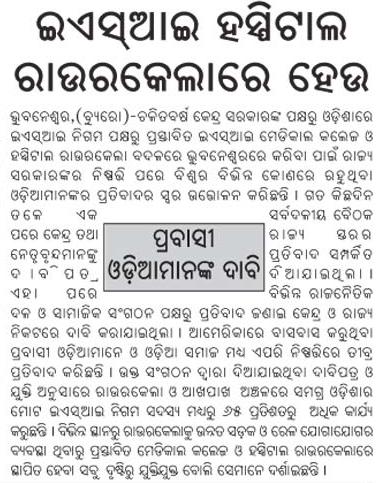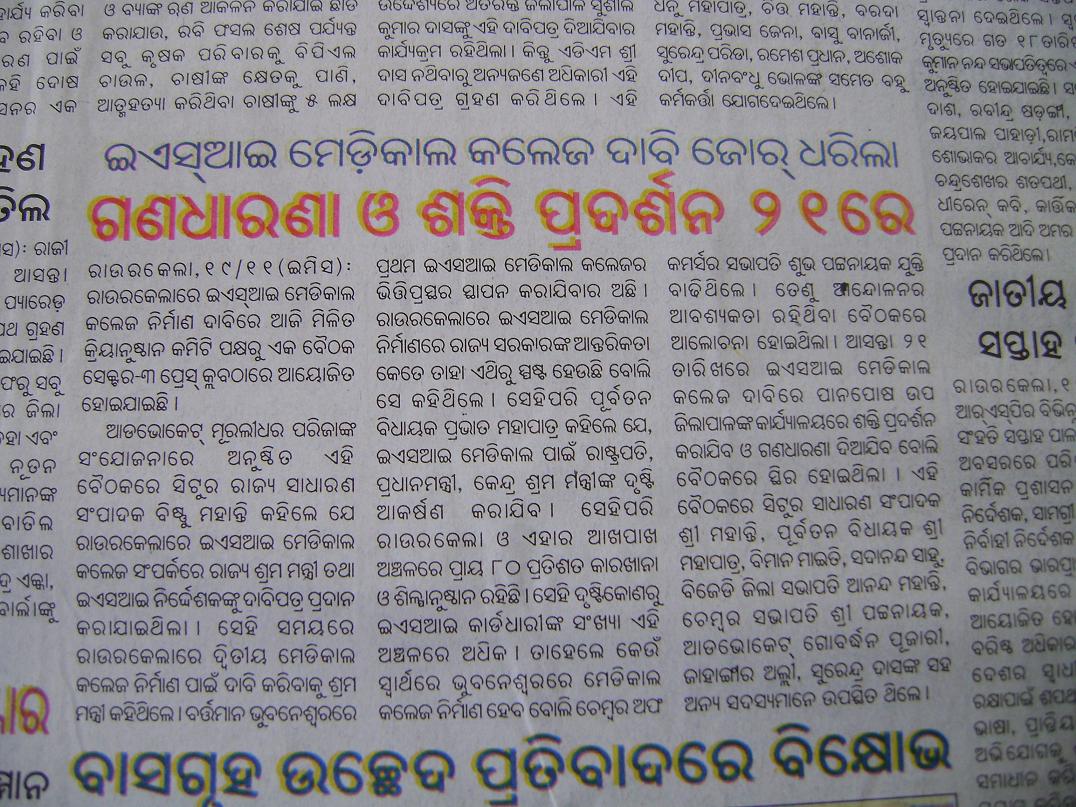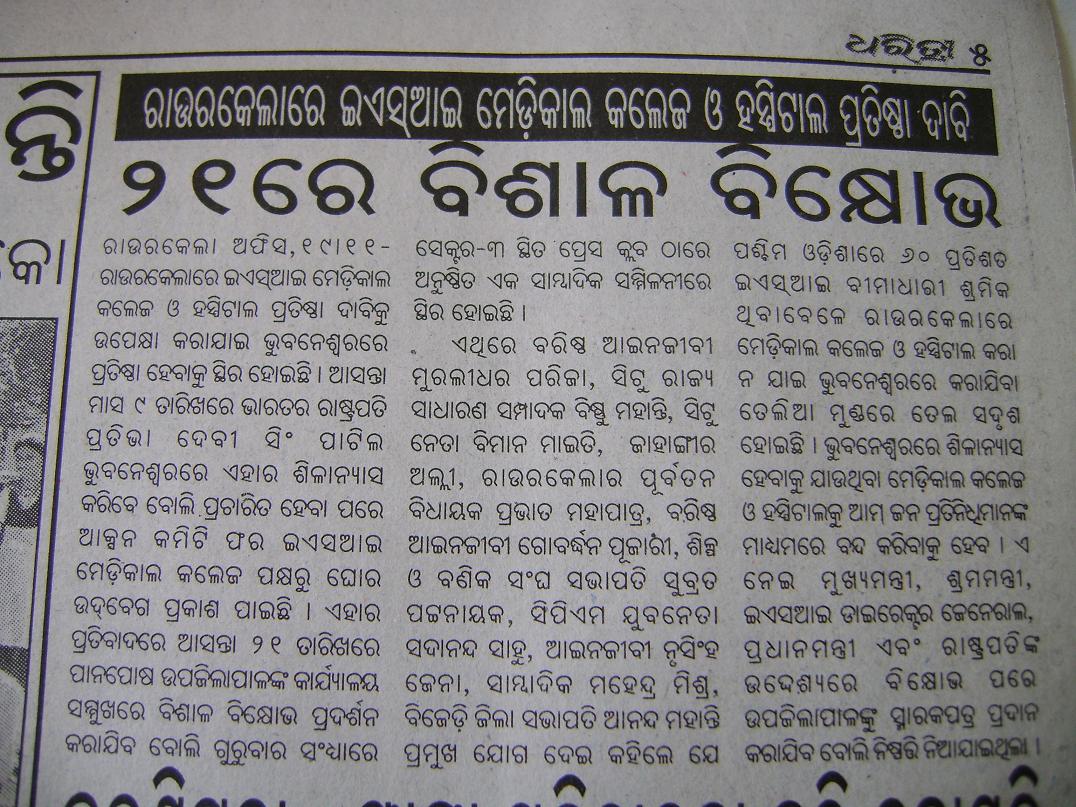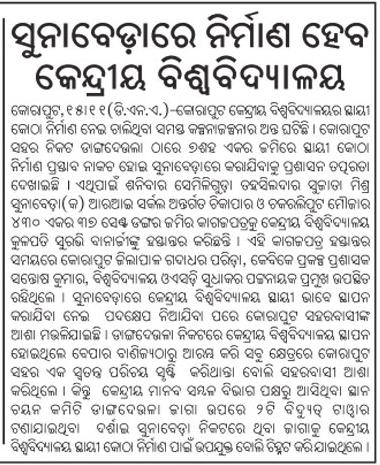Following is gleaned from http://www.iiit-bh.ac.in/downloads/mandotaryDisclosure-2009.pdf?attredirects=0&d=1. Below I just give the name and the degrees. For other important qualifications such as experience, please see the above mentioned document.
- Dr. Gopal Nayak, Director. B.Tech and Ph.D IIT Kharagpur.PGDM IIM Bangalore.
- Ajit Das, Dean and Professor. B. Tech IIT Khragpur. M. Tech Utkal. Pursuing PhD at Utkal.
- Ramesh Chandra Balbantray, Assistant Professor, M.Sc and M.Phil in Maths from Utkal, M.Tech in CS from Utkal, Ph.D thesis submitted in 2007 at Utkal.
- Ashok Das, Assistant Professor, M.Sc Mathematics IIT Kharagpur, M.Tech Computer Science and Data Processing, IIT Khragpur., Ph.D in Computer Science & Engineering submitted in June 2008 at IIT Kharagpur.
- Anjali Mohapatra, Senior Lecturer, M.Sc and M. Phil in Physics, Utkal, M.Tech in Computer Science, Utkal, Continuing Ph.D at Utkal on Computational Molecular Biology.
- Dr. Monalisa Ray, Senior Lecturer, M.Sc Physics Ravenshaw/Utkal, Ph.D in Physics, Utkal.
- Dr. Tanutrushna Panigrahi, Senior Lecturer, MA and Ph.D in English from Berhampur University.
- Dr. Rupaj Nayak, Senior Lecturer, MA and Ph.D in Mathematics from Utkal.
- Dr. Biswajit Pradhan, Lecturer, MSc Berhampur and PhD in Physics IIT Bombay.
- Dr. Satyanarayan Pal, Senior Lecturer, M.Sc in Chemistry Vidyasagar University, Ph.D in Chemistry, Univ. of Hyderabad.
- Muktikanta Sahu, Lecturer, B.E , BIET Bhadrak, M.Tech CET in CS & IT.
- Lipika Das, Lecturer, MA in English Utkal, Continuing Ph.D at Utkal.
- Usharani Rout, Lecturer, B.E Electrical IGIT Sarang, M.Tech BIT Mesra in Control System.
- Puspanjali Mohapatra, Lecturer, B.E Electrical IGIT Sarang, M.Tech Computer Science, Utkal, Continuing Ph.D at Utkal.
- Dr. Hiranmayee Satpathy, Lecturer, M.Sc Chemistry Utkal, Ph.D in Polymer Chemistry, IIT Kharagpur.
- Bamadev Sahoo, Senior Lecturer, BE Mechanical IGIT Sarang, M.Tech Aerospace Eng from IIT Kharagpur, Continuing Ph.D in Mechanical at Jadavpur University.
November 30th, 2009
Following is from the PIB http://pib.nic.in/release/release.asp?relid=54643.
RAJYA SABHA
The Government is in the process of working out an Implementation Plan for the recommendations of the National Knowledge Commission, which envisage, inter-alia, development of modern Libraries across the Country.
This was stated in a written reply in the Rajya Sabha today by the Minister of State for Planning and Parliamentary Affairs Shri V. Narayanasamy.
AD/DB
The National Knowledge Commission’s recommendation on development of modern Libraries across the Country is at http://www.knowledgecommission.gov.in/recommendations/libraries.asp and http://www.knowledgecommission.gov.in/downloads/recommendations/LibrariesLetterPM.pdf . The annexures in the later has details.
It is a good document and talks about the staffing level of various levels of libraries and what services they should offer, but it does not come out and clearly emphasize that libraries should be made at state level, district level, block level etc. and a funding scheme should be devised for that.
November 26th, 2009
Following is from http://pib.nic.in/release/release.asp?relid=54595.
Rajya Sabha
In compliance of the announcement of Hon’ble Prime Minister on 15th August, 2007 to set up 1600 Industrial Training Institutes (ITIs) & Polytechnics and 50,000 Skill Development Centres with active help of the private sector, DGE&T, Ministry of Labour & Employment has undertaken a project titled “Kaushal Vikas Yojana” to set up 1500 Industrial Training Institutes (ITIs) & 5000 Skill Development Centres (SDCs) in Public Private Partnership (PPP) mode in the country at locations identified by the State Governments. ITIs are proposed to be set up in unserviced blocks (blocks where no ITIs/ITCs exist) & SDCs in a cluster of about ten villages.
State Governments have been requested to identify locations where free of cost land and basic infrastructure such as power, water, road, etc. are available.
Establishment of such institutes involves three partners (i) Private Training Provider playing the leading role (ii) State Government providing land free of cost and basic infrastructural support and (iii) Central Government providing Viability Gap Funding (VGF), if needed. Depending on the locations, various options are proposed to be explored. Funding pattern may vary from place to place.
The Govt. is in the process of preparing Detailed Project Report with the help of a Transaction Advisor and obtaining mandatory approvals. The project is likely to be rolled out in the next financial year.
This information was given by the Minister of State in the Ministry of Labour & Employment Shri Harish Rawat in a written reply in the Rajya Sabha today.
VBA/RS
Following is from another PIB http://pib.nic.in/release/release.asp?relid=54594
Rajya Sabha
A project titled “Kaushal Vikas Yojana” has been taken up to set up 1500 Industrial Training Institutes (ITIs) & 5000 Skill Development Centres (SDCs) in Public Private Partnership (PPP). These ITIs are proposed to be set up in unserviced blocks (blocks where no ITIs /ITC s exist) & SDCs in a cluster of about ten villages.
The purpose of setting up these institutions is to provide access to vocational training facilities to youth in rural, hilly, border & difficult areas. It is expected to provide opportunities of Skill development at door step of youth. Participation of private sector is expected to increase the number of vocations; impart quality & relevant training according to requirement of different sectors of economy and seek their assistance in placement of skilled youth.
This information was given by the Minister of State in the Ministry of Labour & Employment Shri Harish Rawat in a written reply in the Rajya Sabha today.
VBA/RS
November 25th, 2009
Following is from http://pib.nic.in/release/release.asp?relid=54585.
LOK SABHA
The National Sample Survey (NSS) data for 2004-05, indicates rural-urban disparities, gender disparities, inter caste disparities, imbalances in access opportunities for tribal population of the country, disparities amongst religious groups and differences in enrolment rates between the poor and non-poor. The Gross Enrolment Ratio (GER) in higher education for the nation as a whole as a percentage of the population cohort in the age group of 18-24 years is 12.4% based on 2007 enrolment data whereas the GER in secondary education (class XI-XII) as a percentage of the population in the age group of 16-18 years is 28.96% based on data reported in Selected Educational Statistics of 2006-07.
During the Eleventh Plan establishment of Central Universities in hitherto uncovered States has been envisaged. 15 New Central Universities have been notified on 15.1.2009 and another Central University has been established in Jammu Division of the State of Jammu and Kashmir. The Indira Gandhi National Tribal University (IGNTU) has been established for facilitating and promoting studies in areas concerned with the way of life of the tribal population in the country. A new Regional Centre of the IGNTU has been inaugurated in Manipur. University Grants Commission (UGC) has invited detailed project proposals from State Governments for Establishment of 374 model degree colleges in the districts having GER lower than national level with the Centre-State funding in the ratio of 1:1 for Special Category States and 1:2 for other States. The Eleventh Plan has schemes for incentivizing State Government for setting up of new institutions or expansion of existing institutions with Central assistance with focus on underserved areas, strengthening colleges and State universities with focus on underserved areas which are not presently eligible for receiving assistance from UGC to enable these institutions to fulfil the criteria for UGC assistance, additional assistance to State universities and colleges which are already declared fit to receive grants under Section 12B of the UGC Act. The All India Council for Technical Education (AICTE) has permitted second shift in certain engineering colleges and polytechnics. Expansion of intake in Central Educational Institutions by 54% has been undertaken consequent to the implementation of the Central Educational Institutions (Reservation in Admission) Act, 2006. A scheme of interest subsidy during moratorium period for students accessing educational loans for technical and professional education has been notified on 8.9.2009.
This information was given by the Minister of State for Human Resource Development Smt. D. Purandeswari, in a written reply to a question, in the Lok Sabha today.
MV/Hb
November 25th, 2009
Cafe Coffee day is a coffee outlet company which has 833 cafes across 118 cities, mostly in India. Often there is a correlation between number of people working in the "knowledge" sectors and coffee drinking. Using that parameter following is a ranking together with their metro ranking based on the Gazetteer.
- New Delhi+Gurgaon+NOIDA( 114+26+18=158 ) – metro rank 2
- Bangalore (141) – metro rank 5
- Mumbai (120) – metro rank 1
- Pune (49) – metro rank 8
- Chennai (45) – metro rank 4
- Kolkata (38) – metro rank 3
- Hyderabad (37) – metro rank 6
- Ahmedabad-Gandhinagar (16+3=19) – metro rank 7
- Jaipur (15) – metro rank 11
- Chandigarh+Mohali(10+4=14) – metro rank 45
- Vadodara (9) – metro rank 20
- Bhubaneswar+Cuttack(7+1=8) metro rank 22, Goa (8), Nagpur(8) – metro rank 14
- Coimbatore (7) metro rank 23, Mysore(7) – metro rank 34, Mangalore-Surathkal (6+1=7) – metro rank 66
- Bhopal (6) – metro rank 17, Kochi (6) – metro rank 24, Guwahati (6) – metro rank 44, Indore (6) – metro rank 15, Ludhiana (6) – metro rank 19
Although the above is just for fun and I can see at least some inaccuracies (for example, Bangalore should probably at the top, and Hyderabad should be at least above Kolkata) it does make some sense.
In the context of Orissa, I think Bhubaneswar has a decent chance to be in the top 10 knowledge hubs of India within a few years, and not just in terms of coffee outlets; the top 8 are untouchable for Bhubaneswar (for at least the next decade), but it is a fair game after that.
November 25th, 2009
Update: Pioneer also writes about this.
Following is an excerpt from a report in expressbuzz.com.
First Published : 23 Nov 2009 04:16:00 AM IST
Last Updated : 23 Nov 2009 09:17:24 AM IST
BHUBANESWAR: Four senior Congress MPs from Western Orissa have demanded establishment of the proposed ESIC medical college and hospital at Rourkela in Sundargarh district instead of near the Capital for which the State Government is insisting on.
Though the maximum number of industrial and mine workers reside in the area which is tribal dominated, it has been neglected in the health sector since Independence, the four MPs said in a letter to Prime Minister Manmohan Singh.
The four MPs, former chief minister Hemananda Biswal, former Union minister Bhakta Charan Das, former minister Amarnath Pradhan and Sanjay Bhoi, said that the area includes border districts and industrial belt of Jharsuguda, Deogarh, Keonjhar, Bargarh and Sambalpur. Out of the 2.4 lakh ESI insured persons in the State, 1.4 lakh are from this area, they said and added that the first public sector integrated steel plant was established at Rourkela in 1955.
… While the All India Institute of Medical Sciences (AIIMS) is going to be set up near Bhubaneswar, another medical recommended by the Human Resource Development Ministry will be set up in the coastal district. Besides, another medical college recommended by the Ministry of Railways will be established at Bhubaneswar. Two more medical colleges have been recommended to be set up Koraput and Talcher. Bhubaneswar city also has three private medical colleges and hospitals, they said.
This could be the turning point on this movement. Thank you MPs for finally doing this; better late than never.
The above report has a new piece of information in the last paragraph that I have underlined. I wonder what that refers to.
November 23rd, 2009
Following is an excerpt from a report in DNA.
The Indian Institute of Technology, Gandhinagar (IIT-GN) will begin an ‘earn while you learn’ offer for its undergraduate students. …
"Selected students from the second-year batch will be allowed to work for a maximum of eight hours a week during the semester, and 40 hours per week during the vacations.
They will be paid a remuneration of Rs50 to Rs80 per hour. Initially, 25 to 30 students will be selected for the programme," said Jaison Manjaly, assistant professor and faculty coordinator for the programme.
… "The students will be engaged in the library, computer centre, laboratories, general administration, placement services, public relations etc," he said.
… Sudhir Jain, director of IIT-GN, said that … students with a CPI of seven and above will be eligible for participation in the programme.
November 23rd, 2009
Earlier this year Delhi College of Engineering became a state university and changed its name to Delhi Tech University. On November 10th, after 100 days of its completion as a university its VC had the following to report.
The Vice Chancellor informed the gathering that four new undergraduate courses and six new postgraduate courses have been added from 2009-10 in areas of high relevance to the country. "Nano-Science and Technology, VLSI Design, Microwave and Optical Communication, Software Engineering, Information Systems, Power Systems are the areas in which DTU has made a modest yet committed beginning," he said. The University has also forayed into management education this year by establishing ‘Delhi School of Management’ to offer MBA program in innovative areas like knowledge and technology management.
With a view to encourage excellence in education and research, DTU has established an ‘Innovation Fund’ with a seed money of Rs. 10 lakh and has introduced cash awards of Rs. 10,000 for the toppers of each semester, in each discipline and Reward of Rs 10,000 for faculty members who publish research papers in International Journals of High Impact Factor. The University has also recruited about 22 new faculty members at various levels recently.
… The thrust areas of R&D at DTU are going to be Biofuel and Clean Energy Technologies, Future Automobile Solutions, Nano Scale Devices and Photonics, New and Smart Materials, Conducting Polymers, Broadband on Power lines, Info Security and Network Management and Socially Relevant Technologies
Following are some quotes from another article about this.
"The total student strength in DTU will be almost three times of its current student intake in the next five years", the VC says.
The VC also announced the beginning of new programs including dual degree programs and integrated Master’s programs in areas of relevance to our country in Medical Engineering, Aerospace Engineering, Bio-informatics, Clean Energy and Environment Technology, New and Smart Materials and Nano-Technology.
Speaking to an NNE correspondent, the VC said that DTU’s board of management has already given its nod to construct a multi-storey academic block; a teaching block housing ICT enabled lecture theatres and additional hostel facilities for both boys and girls.
"As a part of our academic and research plan we shall set up transform selected research laboratories as world class test houses cum research centres, establish a knowledge park cum Technology Incubator in DTU campus to foster i2IP, student and faculty led techno-enterprises and facilitate effective industry institution interaction," Prof. Sharma added.
A finishing school in partnership with the industry and alumni to further boost employability of their graduates is also in the wish list of the VC.
A Staff College for Tech faculty development will also be set up in DTU to support the Faculty Development mission.
Following are excerpts from another recent article on this.
In an endeavour to attract the best talent to teaching and research, a leading technology university here has initiated 25 teaching-cum-research fellowships (TRFs), including 20 at the doctoral level and five at the post-doctoral level. …
Each teaching-cum-research fellow will be enrolled for a full-time Ph D. programme and will take 10 hours per week of teaching work at the B.Tech or M.Tech levels, a DTU statement said.
The incumbents will be initially appointed for two years, which will be further extended depending on academic and research performance.
The expenditure involved in the grant of TRFs has been estimated around Rs.60 lakh per annum, the statement said.
The first ordinance of the university relating to B.Tech. courses has already been approved by the government. The ordinance for M.Tech and MBA programmes was approved by the DTU board Saturday.
Highlighting the achievements of the institution during the last three months, DTU Vice Chancellor P.B. Sharma told the board: "Apart from a major R&D tie-up with US aerospace major Lockheed Martin for developing a next-generation unmanned aerial vehicle,the university has entered into a collaboration with the Groupe Des Ecoles Des Mines of France to foster collaboration, provide opportunities for global experience and facilitate advancement of knowledge in the field of engineering."
Overall Delhi plans 6 specialized universities. Following is an excerpt from an article about this.
Titled `Delhi as the knowledge capital’, and jointly organized by the Department of Training and Technical Education, government of NCT of Delhi and Delhi Technological University (DTU), the conference on Wednesday discussed a strategic framework for giving shape to the varsity system. Three out of the six universities are already functional. They include the National Law School University (NLU), IIIT-Delhi and Dr B R Ambedkar University.
"Under the new model of higher education, a number of discipline-focused smaller universities are being set up, which would be managed by a common apex system. The new institutes planned are the University of Science and Technology, University of Pharmaceutical Sciences and Research, and University College of Medical Sciences,” said Delhi chief secretary Rakesh Mehta.
The conference is being seen as a platform for creating a plan of action for the proposed initiatives of the Delhi government. It also discussed the public-private partnership model (PPP) of education where the Guru Gobind Singh Indraprastha University (GGSIPU) was cited as an instance. In this system, a majority of the affiliated colleges are privately run.
The above has some lessons for Orissa, its VCs and its higher education task force. In particular, the VC of VSSUT, Burla must take note of the speed at which Delhi Tech U is moving. The VSSUT VC must take the opportunity provided by the document being drafted by the Orissa higher education task force and put into it a visionary plan for VSSUT. In regards to BPUT it may have a new VC soon. Hopefully the new VC will help BPUT Rourkela transition from an administrative unit operating from Bhubaneswar to a real university operating from Rourkela.
The VSSUT VC has announced some plans. Following is an excerpt from http://www.alumniuce.com/messages.asp?id=300.
(1) VSSUT is going to organize its First Convocation to award degrees to its 2009 batch graduands in December -2009/January-2010 in the auditorium with an invitation to a reputed personality from the country to deliver the convocation address as Chief Guest.
(2) A Webgroup with teachers and students be formed to develop and maintain our University website to make it one of the best website in the world.
(3)Construction of one 600 seated Boys hostel and 60 seated guest house.
(4) A digital library and 24X7 internet connectivity in the university campus, students hostels and staff quarters.
(5) Appointment of 39 new teaching faculties in next three months time and Phone, PC and Internet facility in individual faculty office rooms.
(7) Revision and Up gradation of Curriculum taking IIT-Kharagpur as a model.
(8) A Big Notice board at the Entrance near Golden Jubilee gate for coverage and information of all events of the University.
(9)Construction of A Big bounded campus with New staff quarters.
(10) Construction of another big auditorium with 2000 capacity.
Following is an excerpt from http://www.alumniuce.com/messages.asp?id=297.
Our priority will be to make the institution as one of the best of the country and for this we are planning to introduce few new branches of engineering courses. Textile engineering is one among them which will help to strengthen the development of the Sambalpuri fabric. We also plan to introduce Nano-science technology, Bio-medical engineering and surgical engineering soon”, the vice chancellor Dr Tripathy told.
According to him, several modification and changes are to be taken place in the infrastructure of the institution once it becomes university. But since it requires lot of expenditure we want to change it in phase manner. “I am meeting the industry secretary soon to place our immediate requirement. I am hopeful the government would give proper attention to solve the problem of the institution. We have shortage of faculty members. About 44 new faculty members are required immediately. So we advertise this in our website and soon we are able to fill up the posts”, Dr. Tripathy told.
These are good steps. VC Tripathy should take the Delhi Tech Univ plans as well has his own plans to our government and use that to leverage more support from the government.
In this regard I would like readers to comment on some future directions for VSSUT. We will collect those and give it to VSSUT VC as well as to the higher education task force. Thanks in advance.
November 22nd, 2009
I came across this ad in Samaja today.
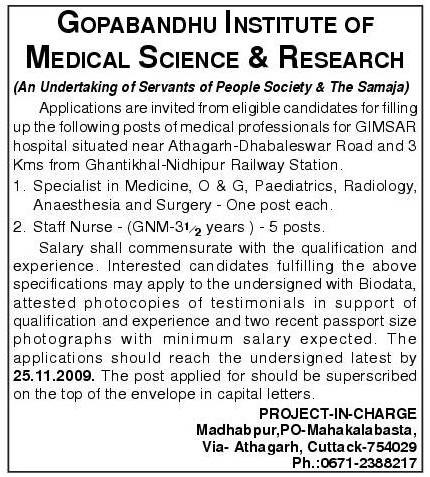
Looking for more information on this institute I came across the following in the page http://www.thesamaja.com/content.php?key=4.
About 80% of the net profit of The Samaja is spent for the welfare activities of the people of Orissa by way of extending stipend to needy students, by helping the patients and victims of natural calamities and through miscellaneous charity and donations. A large amount goes to the Gopabandhu Institute of Medical Science and Research which is in the verge of completion at Athgarh, Orissa.
Looking in Orissa links, I found the following in https://www.orissalinks.com/archives/245.
“The Samaja Group (Lok Sevak Mandal)” has shown interest to establish a medical college cum hospital in Cuttack district.
So perhaps Gopabandhu Institute of Medical Science & Research may some day become a medical college.
Just came across the following ad in nijuktikhabar.net. So it seems this institute has or about to start a nursing college.
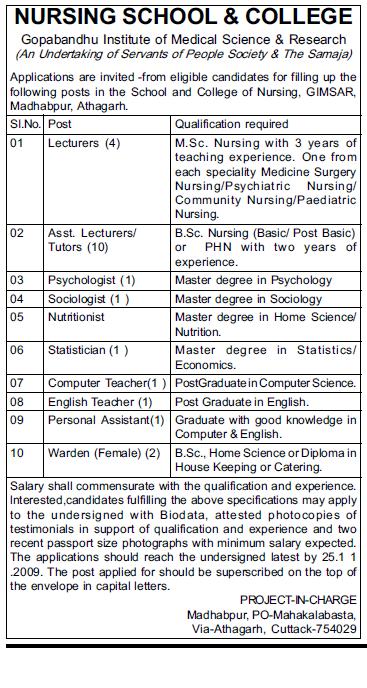
The following news item from Samaja better reflects the current status.
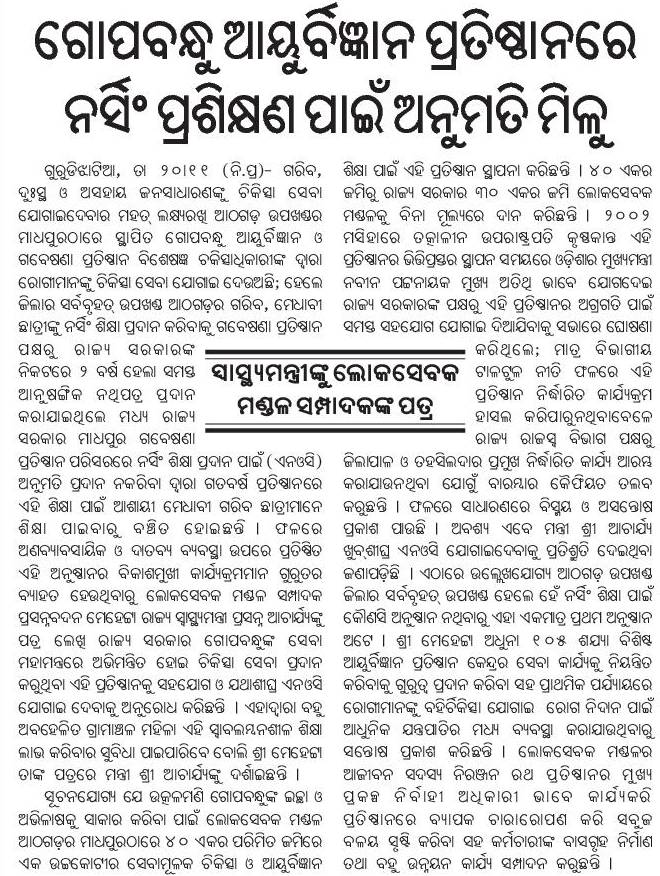
November 21st, 2009
Following is an excerpt from the blog entry at Education-In-India.
… some details about the Azim Premji University (APU).
- The APU will be an institution of excellence in the area of education to develop outstanding education thinkers & leaders, and also serve as a think tank for long-term education change and sustainable development. Akin to the IITs, AIIMS, IIMs and the NLSUI respectively focussed on Science & Technology, Medicine, Management and Law, the APU will in effect be an IIE focussed on Education.
- The APU’s vision is to promote, conceptualize and create a paradigm shift through development of outstanding leadership, research, knowledge and ideas for education and allied development sectors.
- The objectives of the APU include
- Creating Intellectual Capital: through research based theory and outstanding, creative and socially committed leaders and thinkers. Expand the frontiers of knowledge in education and allied disciplines
- Practice informed by sound theory: Serve as a national education resource center and present an alternative authentic voice for educational and social change
- Demonstrating models for effective development of teachers and education leaders
- The APU has been set up through a section 25 company and will be autonomous and self-funded with no dependency on funds from the Karnataka Government.
- The Azim Premji University Ordinance 2009, was passed by the Karnataka Government in November 2009.
- The APU is being set up on 50 acres of land in Sarjapur, near Bangalore. The land is being provided by the section 25 company, which is acquiring it directly from the owners.
- It will be a fully residential university.
- The APU will not be aiming to recover all its expenditure from tuition fees. Any budgetary gap between income and expenditure will be bridged by funds provided by Section 25 company being established by Azim Premji.
- The first students will join the university in 2011. The APU will start by offering masters level courses and eventually also run a Ph.D. program.
Two lessons from the above:
1. Orissa should move fast on Vedanta University so that it does not lose the first movers advantage to efforts like above that are also backed by people with deep pockets.
2. Orissa should push the upgradation of the existing five Regional Institutes of Education (one of which is in Bhubaneswar) to National Institutes of Education.
November 17th, 2009
Following is an excerpt from a PIB release.
… the Union Health Minister Shri Ghulam Nabi Azad expressed concern over dilution of original role of AIIMS due to heavy patient load. He said for bringing the research and innovation to the fore it is important to decongest the institute. Outlining his strategy for this Shri Azad said that the establishment of 8 AIIMS like institution and upgradation of 19 government medical colleges along with strengthening of health infrastructure at rural, district and state level will reduce the pressure on AIIMS. Speaking with the Journalists after the function the minister said that most of the clearances for the AIIMS like institutions have been procured and civil tenders are being issued. He informed that taking cue from his experience in Jammu and Kashmir where he was the Chief Minister he has incorporated a strong monetary incentive for fast completion of these projects. The Hospital – OPD complex is to be built in 24 months. The Minister informed that incentive upto Rs 10 crore will be given for the early completion of work.
November 17th, 2009
Following is an excerpt from a report in Expressbuzz.com.
Ayurvedic treatment, for instance, is now a Rs 8,000-crore industry, and growing at 20 per cent annually. And so you have Ramesh Vangal, former head of Pepsi India, having established an ayurveda firm, now merging it with Coimbatore Arya Vaidya Pharmacy to become the largest ayurveda company in India. Yash Birla has taken a majority stake in Kerala Vaidyashala, the therapy chain. Ayurvaid Hospitals, promoted by a Kochi-based group, got equity investment of Rs 4.5 crore last year from a US-based fund. And the Tata Group has now agreed with an NGO to jointly set up an Institute of Ayurveda Integrated Medicine near Bangalore, to offer formal graduate and postgraduate degrees, beside a 100-bed ayurveda and yoga hospital, plus research and drug production. The Tatas are putting in Rs 34 crore for the IIT-type institute. There are similar plans from the Mata Amrithanandamayee trust.
All this is excellent news, for the simple reason that when business gets into the picture, documentation and systems and reports have to be put in place. This has been the problem all along with what are loosely called alternative systems of medicine to standard allopathy. Each practitioner has his or her own way of doing things and you have to accept this on trust. And if something works, there is no publicly accessible system of how and why. One outcome has been the mutual scorn between allopathy and these other systems of treatment, with close to no attempt at reaching out to each other or researching if each can usefully learn from the other and so, improve itself. The public would benefit enormously if they could go to one place and get the combined benefit of different systems of knowledge working in tandem. You will never get this unless these processes are all systemised, subject to peer and public review, and are allowed to be replicated in a laboratory setting: this is the way knowledge progresses. If business and investors take a hand, this process should get a push. As, for instance, with the proposed Tata university.
November 16th, 2009
Following is an excerpt from a report in Business Standrad.
The national design policy had recommended setting up institutes on the lines of NID in various parts of India to promote design programmes. Under this initiative, the government has narrowed down on Andhra Pradesh, Assam and Madhya Pradesh for setting up the new NIDs in the next two to three years. Cities like Hyderabad, Jorhat, Bhopal and Gwalior are some of the cities that have been shortlisted. An NID will also be set up in the Northern part of India for which target cities are yet to be finalised.
Interested state governments have offered around 30-50 acres of land for setting up the institute. Each NID will gradually have an intake of 1000 students. The national design policy had stated that public-private partnership mode could be an option for setting up these new institutes but sources say that no call has been made by the government for private partners as of now.
At present NID has campuses in Ahmedabad, Gandhinagar and Bangalore. The institute runs 8 programmes in the Ahmedabad campus, 5 in Gandhinagar and 3 in the Bangalore campus. The Bangalore campus is the institute’s R&D campus where there are 30 students for the three programmes.
November 16th, 2009



